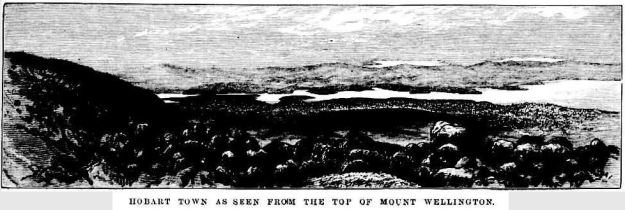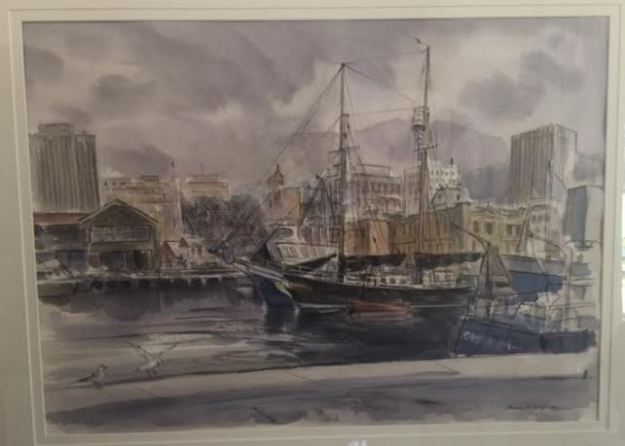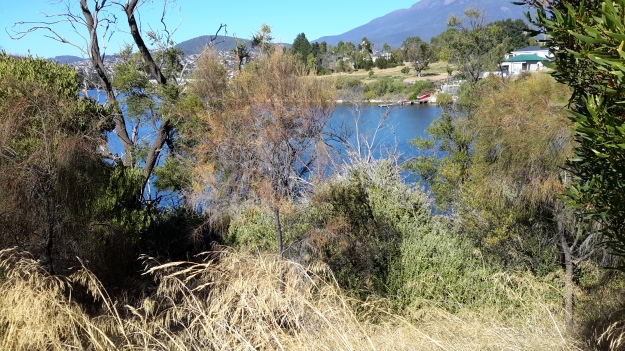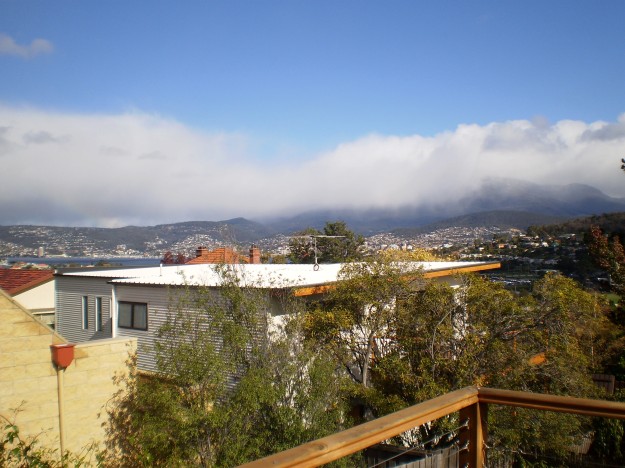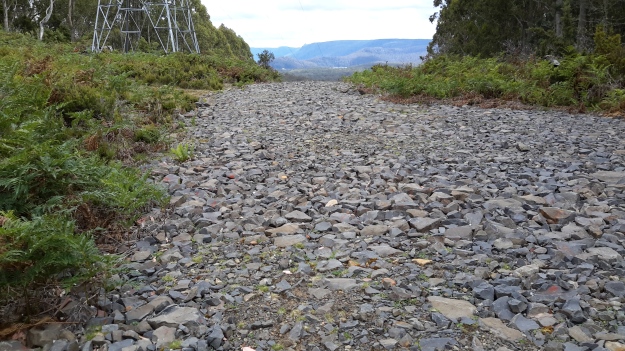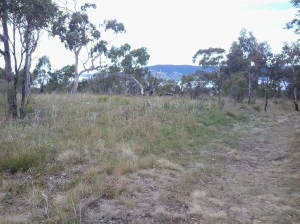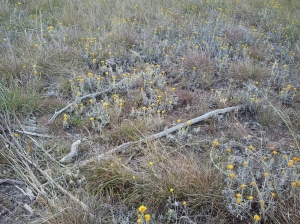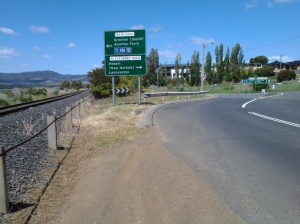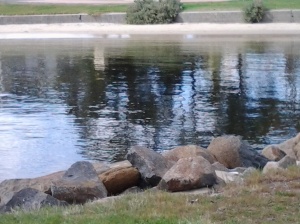Before reaching the plain, I stepped across a couple of tiny rivulets the waters of which were heading to Lake King William. The map indicated I should expect a number of these. None impacted on the ease of the walk. 
After walking approximately two thirds of the length of Lake King William from the south northwards, the track ended in a mire of deep dry criss-crossing ruts a few hundred metres inland. Obviously when the land was wet, vehicles had tried to continue onto the plain using bits of driftwood to give purchase – but the ruts soon stopped so I knew these man-made beasts had retreated, albeit with difficulty. My photo below, with Mount Charles looking down, does not adequately present the depth or the complexity of the intrusion of vehicles.

In a recent posting I added in a link to Tassie Rambler’s blog . I suggest you revisit that site to look at the photographs showing what the area looks like when wet. Look for Mount Charles in the photos and then, in the photos that follow, you can see the wet plain that the Tassie Rambler experienced. I am immensely grateful for the dryness I found.
Mount Charles looked down on the plain which stretched wide and extended perhaps a kilometre inland from the Lake. I knew I needed to aim at the pointed hill (see photo below) in the distance and be prepared to walk around it.

A snaking crevasse meandered through this seeming flatness. My map named Bethune Creek as the main watercourse in the area so I knew I needed to make a water crossing at some stage. My passage point was a log resting on both sides of the land. Crossing Bethune Creek was easy.


The ground either side of the Creek and presumably across the plain was not wet, nevertheless it was springy under foot and I bounced as I walked.
Acres and acres of this ‘ground’ extended in all directions and a decision was required. Should I walk beside Bethune Creek until I was much closer to Lake King William and then try and get through the bush, find a track and continue on solid ground? Alternatively, because I could see the power lines in a row parallel to the plain, I wondered whether I should walk through the bush towards them as soon as I could see an easy route. From where I stood it was not clear that accessing the power line area would be easy or even possible if I proceeded closer to the Lake so I decided to make a path to the power lines through the band of small bushes and undergrowth which seemed to be the narrowest. It didn’t look difficult.
This was where the fun started.
Over the years, bushwalkers have groaned at the memory of experiences crossing button grass plains. Until this walk, I had no experience of walking through these plants. Now I understand bushwalkers’ groans. When you see the images below of the button grass it appears not to present difficulties for walking – but appearances deceive.


Despite the fact I only needed to cover about 100 metres of these beautiful looking plants, it was one of the most exhausting and frustrating processes I have ever endured. However, even as I tried to negotiate the distance, I could see the funny side if someone else had been watching my antics and halting progress.
Each button grass plant has a thick roughly circular base and then sprouts long arms some of which end with a spherical seed case, the button. Around and between each plant run channels which, in wetter times, would be a muddy, marshy, boot-removing quagmire. Thankfully, these channels were bone dry when I made the crossing. The channels were the width of one of my feet so on occasion I tried to walk in the channels. The channels are deep so that the top of the surrounding button grass plants were sometimes around my armpit height. This meant seeing the best forward path was not always possible. After making a few steps around a few plants, I would think I had found a way to continue reasonably comfortably, albeit not in a straight line to my destination. Then suddenly a mesh of grasses from a number of close growing plants would be so thick that I could not force my way through nor step over. Then I would hump myself up to balance in the middle of a grass plant, my backpack changing my centre of gravity. The irregularity of the height and thickness of the plants required constant rebalancing to stay upright. And I didn’t stay upright. I couldn’t. So I would fall onto my back perhaps across a plant or two or perhaps into or straddling a channel. I lay there, rather like a beetle with legs and arms flailing in the air where turning over or getting up seems impossible. Then I would unhitch my back pack, firm my footing in a channel, load my backpack on, and start again. How many times did this happen? I cannot say. But the landings were always soft and not jarring. These were gentle falls backwards offering marvellous sky views!
After much time – was it an hour or more? – the vegetation changed to a combination of few button grass plants, a nice little short spiky leaved plant (mind over matter was required to proceed through this), and a deeply spongy moss.
In the photo below, across the low level growth, the taller spiky plant can be seen left of centre, and the pale green plant in the foreground is the moss. Again this photo shows a landscape that looks easy to walk through. I promise you that looks deceive greatly. The ground beneath the plants was uneven, and some of the plants were deeply compressible by different degrees.

I do not think the soft mossy plant, which slowed my progress considerably, was Sphagnum Moss one of Tasmania’s endemic species; however I am unable to identify it. Looking firm, I would step onto a smooth looking mass and that foot might sink a few inches, twelve inches, or I might drop down to knee height in the mass. Meanwhile the other foot and leg stayed elsewhere up someplace on another firmer plant. Unused muscles got a stretch. Keeping my balance was crucial because falling on the spiky plants held no allure.
A couple of years ago I attended classes to learn to dance the Argentine Tango in which balance is critical to success. During the dance, the man leads and the woman may need to stay balanced mid move on one foot for an unknown time. This means every time I made a step I needed to be prepared to stop, not sway, and keep centred. The dance experience proved useful in Tasmania’s wilderness as I negotiated a path through these plants. Speed was never an option.
I am not proud to say that I disturbed the landscape on this section of the walk. However, the extraordinary resilience of the plants on which I stepped amazed me. They bounced back to their original shape immediately. When I stepped off the button grass plants and the moss, I could not see any mark of where I had been, although I recognise that at a micro level (perhaps even closer inspection) my steps would be in evidence on these plants.
Eventually I reached the power line clearway. It wasn’t clear. Dreams of easy walking remained dreams.

